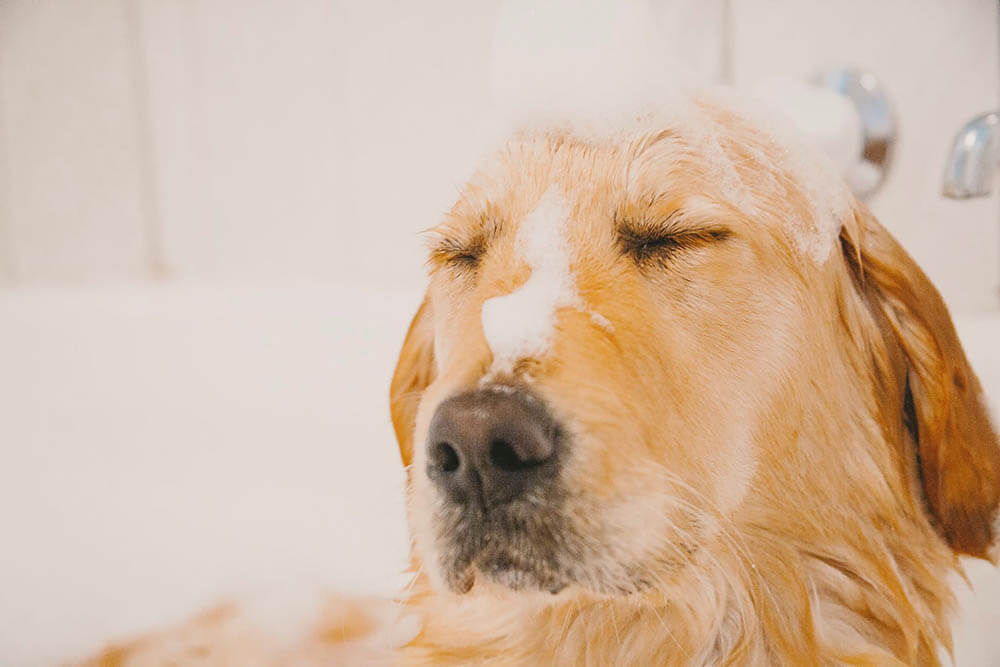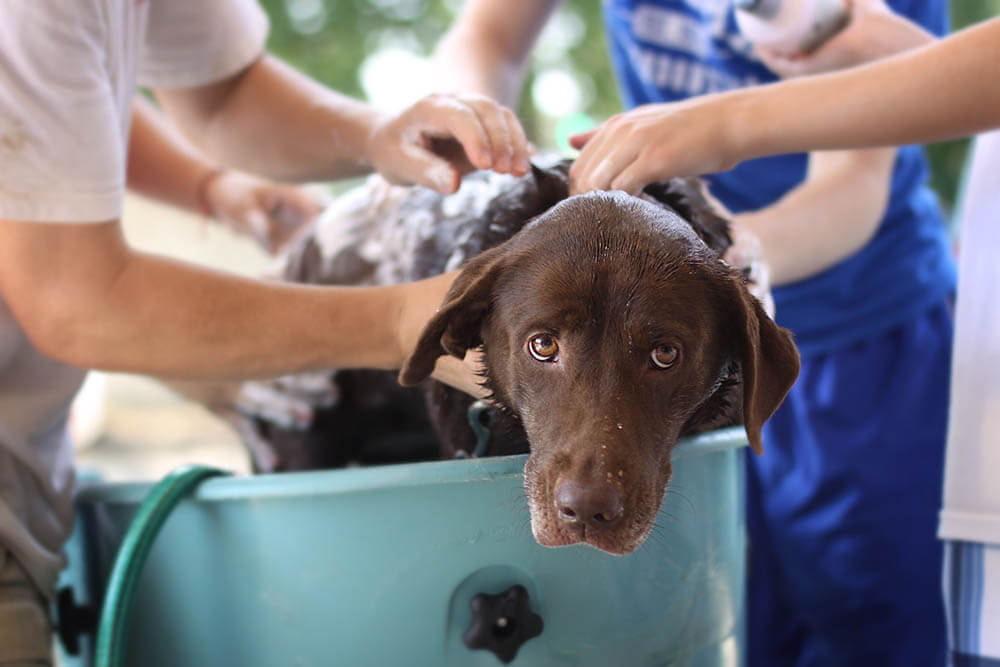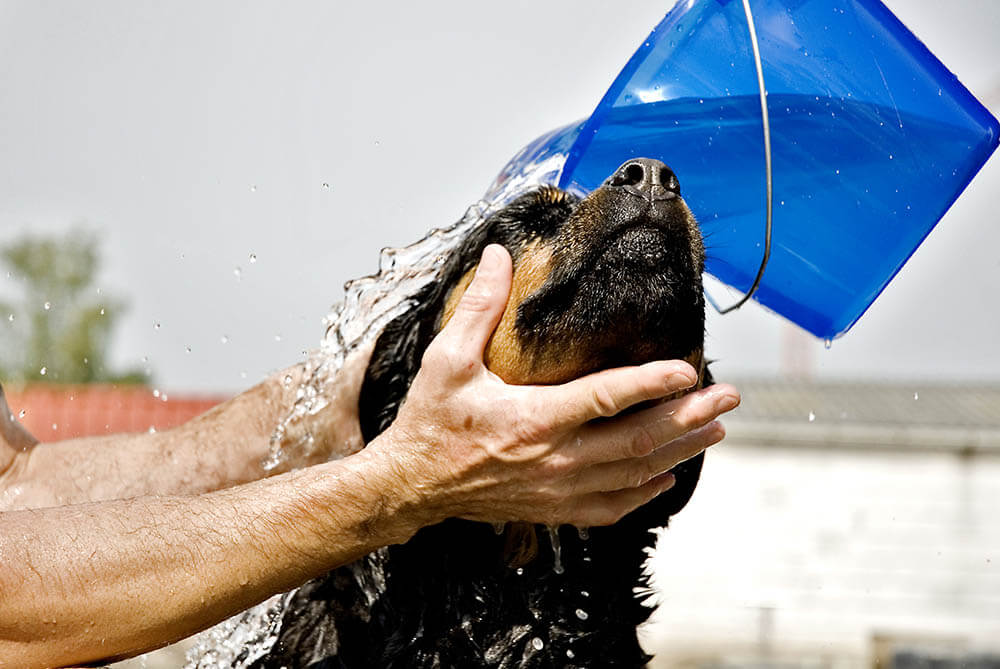Do you struggle to get your dog into a bathtub? Does your dog stare at you as if you’ve just betrayed them when rubbing shampoo into their fur? Do they bark and grumble as if the water is melting them? If so, then you’ve experienced first-hand what it means when people say “dogs hate baths.”
It’s true: most dogs don’t have a great relationship with bathing. And they’ll do anything – from whining your ears off to trying to jump out of the tub – to escape the situation.
But why do dogs loathe baths? And what can you do to make the experience less of an ordeal for them?
Keep reading to find out!

9 Reasons Why Dogs Hate Baths
Believe it or not, there’s more than one reason why dogs hate baths. They’re all closely related, though, because they all have something to do with canine anxiety, stress, and fear.
Let’s tarry no longer; here are the 9 reasons why dogs hate baths!
1. Loss of control
We’ve seen videos of dogs jumping into streams, splashing around, and enjoying themselves. So why do dogs hate taking baths? Isn’t it the same thing?
No, it’s not. Dogs enjoy being in control, and being forced to take a bath is the opposite of that. When you’re bathing your dog, they can’t move around like they want to because you’re the one moving them around. It’s not even their choice to get wet – it’s yours.
It’s also upsetting for a dog to be restrained during a bath, which is what typically happens at the groomer’s. Though this is for both the dog and the groomer’s safety, your dog doesn’t know this. All they know is that they’re not in control, and they don’t like it.
2. Handling
Not all dogs are the same; every individual canine has a unique personality, likes, and dislikes.
Some dogs don’t like being held or cuddled. This can be a problem during bath time, when the owner has to hold their dog, run their hands over their fur, and reposition their entire body in the tub.
Dogs with anxiety issues are more likely to dislike being handled whether or not it’s during bath time.
3. Unfamiliarity
Like all animals, dogs are wary of things they aren’t used to. So if your dog is having their first bath, or you don’t bathe your dog often, it’s only natural for them to be upset. Shampoo, soap, the shower nozzle, the slippery tub – these are all strange things that can cause anxiety and stress in a dog unfamiliar with the concept of bathing.
4. Contagious stress
Bathing a dog can be frustrating for owners especially if the anxious pet makes a fuss and refuses to comply with commands. This can result in the owner raising their voice, handling their pooch roughly, and rushing the whole process.
Dogs are extremely good at picking up on their owners’ moods. If they sense you’re unhappy, they grow unhappy, too. They then start dreading bath time because they know it just stresses the both of you out.

5. Strange noises
The sound of water rushing out of a shower nozzle can be soothing to humans. But to creatures with sensitive hearing – such as dogs – this sound can be unusual, loud, and scary.
If you don’t groom your dog often, you limit their exposure to such noises. Infrequent bathing isn’t necessarily a bad thing, however; plenty of breeds only need to be bathed once a month. Unfortunately, it also means these dogs don’t get many opportunities to be desensitized to the weird noises associated with bathing.
6. Upsetting scents
Dogs have an extremely powerful sense of smell. Any scent that seems faint to us is a feast of exciting odors for our furry friends.
So do dogs enjoy the wonderful, luxurious scents so many soaps and shampoos come with? Most probably not. Canines prefer odors people find offensive, so bath product fragrances are likely overpowering to them. Not only that, these upsetting fragrances stick to their fur, so dogs roll on the carpet or grass after a bath to get rid of all those distressing scents.
In addition, if your dog has sensitive skin, a strongly scented shampoo may end up irritating their skin. This can make bathing even more upsetting than it already is.
7. Uncomfortable water temperature
Like all animals, dogs are sensitive to extreme temperatures. If the water you’re using to bathe them is too hot or too cold, they won’t like it. After the bath, the hot air coming from a blow dryer can also make them uncomfortable.
8. Slippery floor
Because the bathtub floor is particularly slippery when it’s wet, your dog has a hard time finding their footing during a bath. The sensation of slipping and the possibility of falling over are both frightening to dogs.
9. Negative experience
Did your dog have a terrible first bath? Did they get shampoo in their eyes, slip and fall in the tub, get scalded by hot water, or all of the above? Has every following bath been just as painful for them?
Upsetting experiences can leave a dog traumatized. They develop a negative association with bathing, so that every time they observe you preparing the tub for them, they fear you’re about to subject them to another round of torture. It’s for this reason every dog owner should ensure their pet’s experiences with bathing – especially their first one – are as positive as possible.

Tips on How to Bathe Dogs
Is your dog afraid of bath time? The following tips can help!
1. Be positive
When bathing your dog, make sure you don’t project a negative attitude. Instead of expressing frustration, ensure you stay calm. Smile and use a soothing, reassuring tone when talking to your dog. Be gentle when you handle them, too.
Turning bathing into a positive experience for your dog will help alleviate their anxiety during the activity. Eventually, they may even associate bathing with good times.
2. Make the experience fun
By making the bathing fun for your dog, you will counter-condition them to view the activity as rewarding instead of scary.
There are many ways you can make bathing pleasurable. For instance, you can create a trail of treats that leads to the bathroom. You can relocate their food bowl to the bathroom and put some treats on the bathroom floor. You can also smear some peanut butter on the tub’s rim and the wall next to the bathtub. Their favorite toys can also help.
Don’t force your dog into the tub immediately; give them time to form an association between the tub and the treats and toys. Then, put more treats in the bowl and place the bowl in the tub along with some toys.
Allow your dog to climb into the tub themselves. While they’re enjoying their toys and treats, gently sprinkle a bit of water on them. Slowly wet their entire body, then apply shampoo. Don’t forget to praise your dog the entire time.
If at any time your dog shows signs of distress, stop the bath and try again another time.
Note: if you’re going to use peanut butter, make sure it doesn’t contain the highly toxic ingredient xylitol, which is often used in sugar-free food.
3. Prevent negative experiences
Take steps to ensure your dog has no negative bathing experiences.
Never be rough when handling your dog so they don’t associate bathing with discomfort.
To prevent them from slipping and having an accident, place non slip stickers or a non skid mat on the tub’s floor. Alternatively, you can also use a bath harness to keep them stable, though the restriction this provides may upset an overly anxious dog.
Test the water temperature before using it on your dog. They won’t appreciate water that’s freezing or scorching. It should be just right.
For an anxious dog, it might be best to avoid using the faucet or showerhead, as these make noisy sounds that can irritate or scare them. They also won’t enjoy having water sprayed on their face and body. Before bath time, fill one or two buckets with water. When bathing your dog, pour this water gently over their body, then use a wet washcloth to clean their face.
Bathing products should be fragrance-free or lightly scented as well as non-allergenic. Always use dog shampoo and soap, as human products can irritate their skin.
When the bath is done, set the blow dryer to the lowest temperature before using it to dry your dog’s coat.
Other grooming activities, such as brushing your dog’s teeth and cutting their nails, should be saved for another time.
4. Seek help
If your dog is adamant about not taking a bath, then they may be suffering from anxiety issues. This psychological problem has various causes, many of them medical. Therefore, the best way to help an anxious dog is to have a veterinarian or licensed veterinary behaviorist examine and treat them.
Treatments exist for many medical issues that result in anxiety. Dietary supplements and anti-anxiety medication can also calm a dog down before a bath or any other potentially scary situation.

Conclusion
Dogs hate baths, but that doesn’t mean they can’t learn to tolerate or even enjoy them. With the right techniques and a lot of love, you can get your beloved pet cleaned without the fuss and the frustration.
Don’t forget to seek veterinary aid if you suspect your dog is suffering from anxiety issues!
